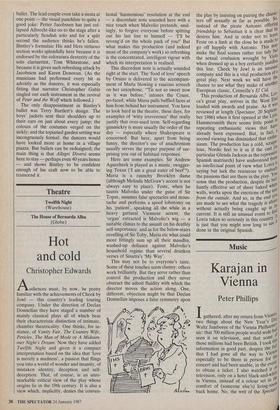Dance
Still winning
Julie Kavanagh
There is something implicitly reassur- ing in the fact that the two runaway successes of SWRB's 40th Anniversary Season were its earliest and newest com- missions: Ashton's Valses nobles et sen- timentales and David Bintley's Allegri Di- versi, with exactly 40 years between them. Other key ballets commemorating the company's choreographic heritage varied in their effect. Solitaire, an uncharacteristi- cally winsome piece of juvenilia by Ken- neth MacMillan has outlived its time, whereas Ashton's Capriol Suite still has irrepressible charm. Cranko's Pineapple Poll is balletic Gilbert and Sullivan however well it's performed, you either enjoy it or you don't; while de Valois's Checkmate demands a tauter, more drama- tic account than it was given for it not to drag. Samira Saidi's interpretation of Love, however, had a svelte acuity which brought home the extent to which her part pays homage to Nijinska's girl in blue — an influence we more often associate with Nijinska is clearly behind the voluptuous use of epaulement in Valses nobles through which Ashton, shaping every contour of the classical silhouette, achieves a wonder- fully fluent three-dimensionality even when the dancers aren't revolving to Ravel's suite of waltzes. Valses nobles was a lost Ashton ballet revived for the birth- day performance by original members of the cast and Sir Fred himself, who has altered the beginning (because he didn't like it) and the end (because no one could remember it). Sophie Fedorovitch's ravishingly simple set recreated by William Chappell, places the dancers — who could be debutantes and their delights — in a ball- room or palm court, and to me also invokes a Thirties photographic studio: the girls in their long white gloves and beribboned gowns, and the boys posed dreamily against a background of gauzy screens and shadows of potted palms, could be sitters in a photograph by Beaton or Hoyningen- Huene.
This is a ballet that exudes atmosphere, style and period (beautifully captured by a cast led by Marion Tait) but it amounts to far more than a series of moving fashion plates. Relationships and rivalries are hinted at — 'like something almost being said', in Larkin's phrase. And at the heart of Valses nobles, preserving its longevity, is a kind of radiance, an elusive poetic quality that only ballet can express and that only certain ballets contain. Bintley's latest piece has it — at last — but not Jennifer Jackson's One by Nine, even though there are things to admire.
Her title refers to her dramatis personae: Apollo (Joseph Cipolla, SWRB's welcome new recruit) and his nine muses — well- trodden balletic ground with few original departures in this case. I liked the illusion of evening shadows created by Deanna Petherbridge's striped stage, but couldn't see the point of the mobile classical pavi- lions which tottered distractingly to one side then another. Jackson assimilates Gre- cian motifs into her traditional vocabulary in a nicely breezy way, but at times the choreography looks mannered and over- wrought. Like the work of many fledgling choreographers, One by Nine derives its existence from the music (Vivaldi's concer- tos) and treats it deferentially but lacks a life of its own.
Not so Allegri Diversi. Bintley catches exactly the melodic enchantment of Rossi- ni's variations and using the music as an imaginative springboard, creates a work that is utterly winning in its own terms. Rossini composed these pieces as a teen- ager in Bologna and Bintley incorporates a youthful, sunny, Italian spirit into the ballet. The lead couple even take a siesta at one point — the visual punchline to quite a good joke: Petter Jacobssen has just col- lapsed Albrecht-like on to the stage after a particularly fiendish solo and for a split second the audience thinks he's fallen. Bintley's formulaic His and Hers virtuoso section works splendidly here because it is endorsed by the coloratura dexterity of the solo clarinettist, Tom Whitestone, and because it is given such refreshing attack by Jacobsson and Karen Donovan. (As the musicians had performed every bit as adroitly as the dancers, it was especially fitting that narrator Christopher Gable singled out each instrument in the revival of Peter and the Wolf which followed.) The only disappointment in Bintley's ballet was Terry Bartlett's design. The boys' jackets sent their shoulders up to their ears on just about every jump; the colours of the costumes verged on the sickly; and the topiaried garden setting was incongruously formal: the dancers would have looked more at home in a village piazza. But ballets can be redesigned; the main thing is that Allegri Diversi seems here to stay — perhaps even 40 years hence — and shows Bintley to be confident enough of his craft now to be able to transcend it.



















































 Previous page
Previous page